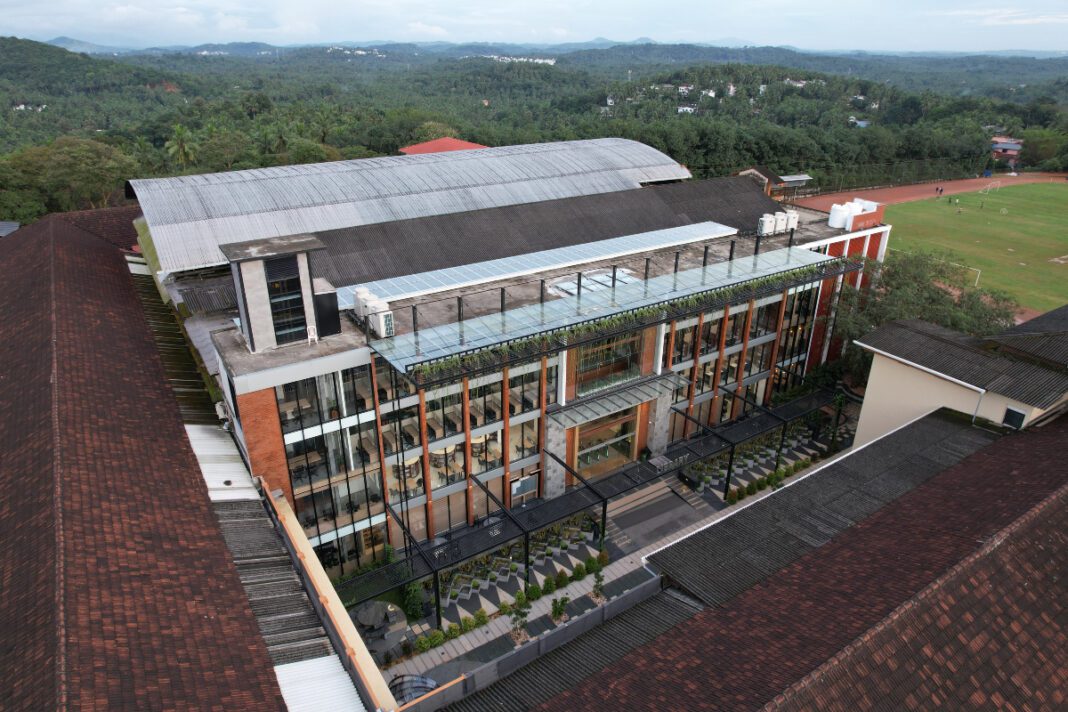The Devagari College Library project is a remarkable convergence of architectural beauty, structural precision, and sustainability. By leveraging pre-engineered steel systems, innovative foundation techniques, and meticulous planning, the project seamlessly fulfilled its architectural vision while overcoming challenges related to the site and budget constraints.
A highlight of the design is the top roof and mid-level glass canopies, which utilise tensile structures to minimise material usage without compromising aesthetic appeal. The spiral staircase and iconic book tower, constructed atop an existing floor, showcase advanced engineering solutions that ensured minimal disruption to college operations. This project stands as a benchmark for innovative, sustainable design and efficient execution in educational infrastructure.
Guided by a vision to create a dynamic, sustainable, and technologically integrated educational space, the library redefines the traditional concept of learning hubs. It serves as a space for knowledge exchange, collaboration, and cultural engagement, offering an inviting environment for both academic growth and community interaction. By blending modern design with functionality, the library addresses the evolving needs of students and educators, making it an accessible and inspiring space for all.
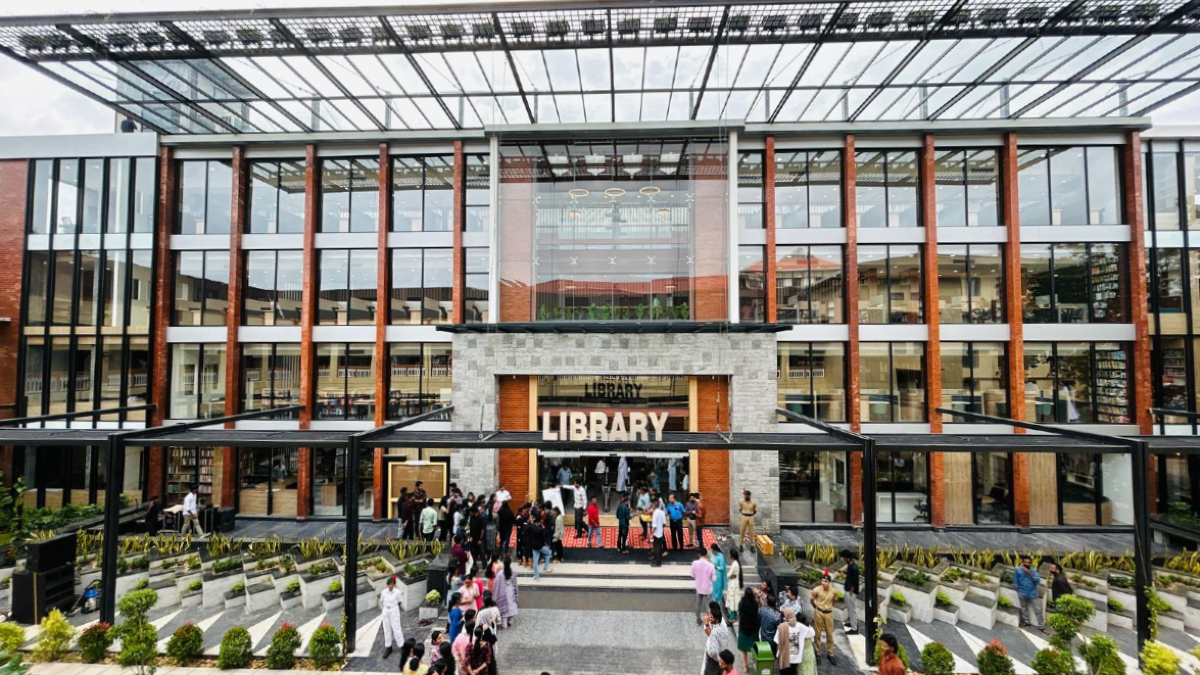
A Library Reborn
The Devagari College Library project involved designing, fabricating, and erecting a four-storey library structure in the college’s quadrangle. Elansa Design Studio provided the architectural design. The project overcame several challenges, including complex site constraints, varied structural demands, and a strict construction timeline. It focused on delivering a structurally efficient and sustainable library, integrating advanced engineering solutions to ensure minimal disruption to the existing buildings and the college’s academic schedule.
The Spiral Staircase
The spiral staircase emerged as an extension of the book tower, designed to create a visually dynamic space defined by books and seating areas, with minimal visible structural elements. This feature offers a sense of surprise and wonder, allowing users to glimpse the college and campus through small gaps between the books. These glimpses connect users to the larger campus context while transporting them to a different, more imaginative realm.
A Suspended Glass Canopy
A cantilevered glass canopy, supported by tensile GI wire ropes, provides functional shade and visual appeal. This feature defines the open reading space, incorporating playful plinth designs to attract more students and make library usage more engaging and enjoyable.
A suspended staircase with glass treads bridges different floor heights, creating an engaging and light-filled space. This design also enhances ventilation and serves as a light well, seamlessly connecting the old and new sections of the building.
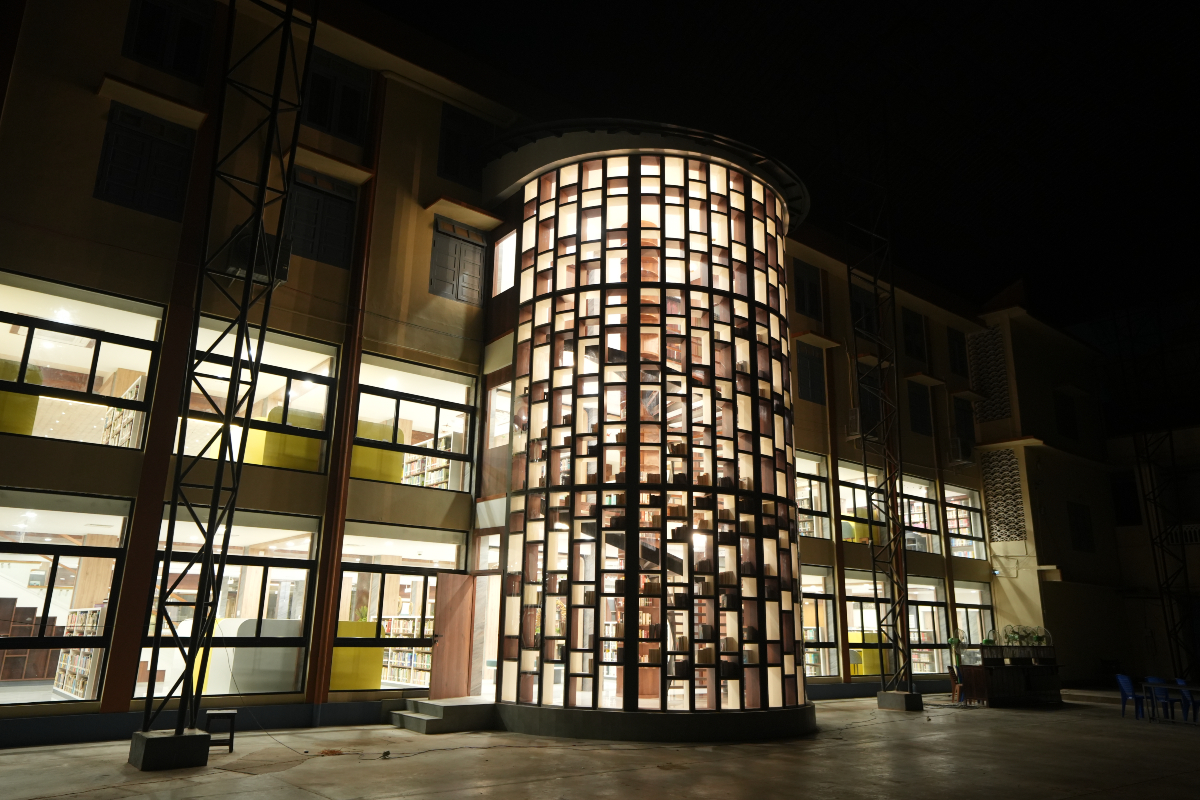
The Book Tower
The book tower offers an intimate and functional use of space, distinct from other reading areas. Here, users are surrounded by books, providing a quiet retreat away from the hustle and bustle of the main library. This design fosters focused study and contemplation in a uniquely immersive environment.
No Holds Barred
The Devagari College Library project presented a unique set of challenges, which were addressed through innovative engineering solutions and meticulous planning.
The site, a quadrangle previously occupied by a basketball court, posed significant constraints due to its location amidst buildings constructed over several decades with varying floor levels. The design required integration with the existing structures without damaging their reinforcements, a task further complicated by the strict budget and tight timeline.
Major structural works were confined to the 45-day summer holiday period to minimise disruptions to college operations, with construction often limited to non-operational hours to control noise and dust.
Architectural requirements added complexity, including cantilevered glass canopies with minimal structural depth and boxed rectangular columns, demanding precision and efficiency. To address these challenges, a pre-engineered steel system was employed, tailored to accommodate the site’s constraints and budget. Fabrication was carried out at an isolated yard 200 m from the site, ensuring efficiency and maintaining quality control.
Beam connections between the new and existing structures were executed using CMS (cover metre survey) and GPR (ground-penetrating radar) scans, paired with chemical anchor bolts to preserve the original reinforcements. The top roof glass canopy, spanning a 7 m cantilever, was designed with ISMB 200 sections in a strut-and-tie configuration, achieving the required slender aesthetic.
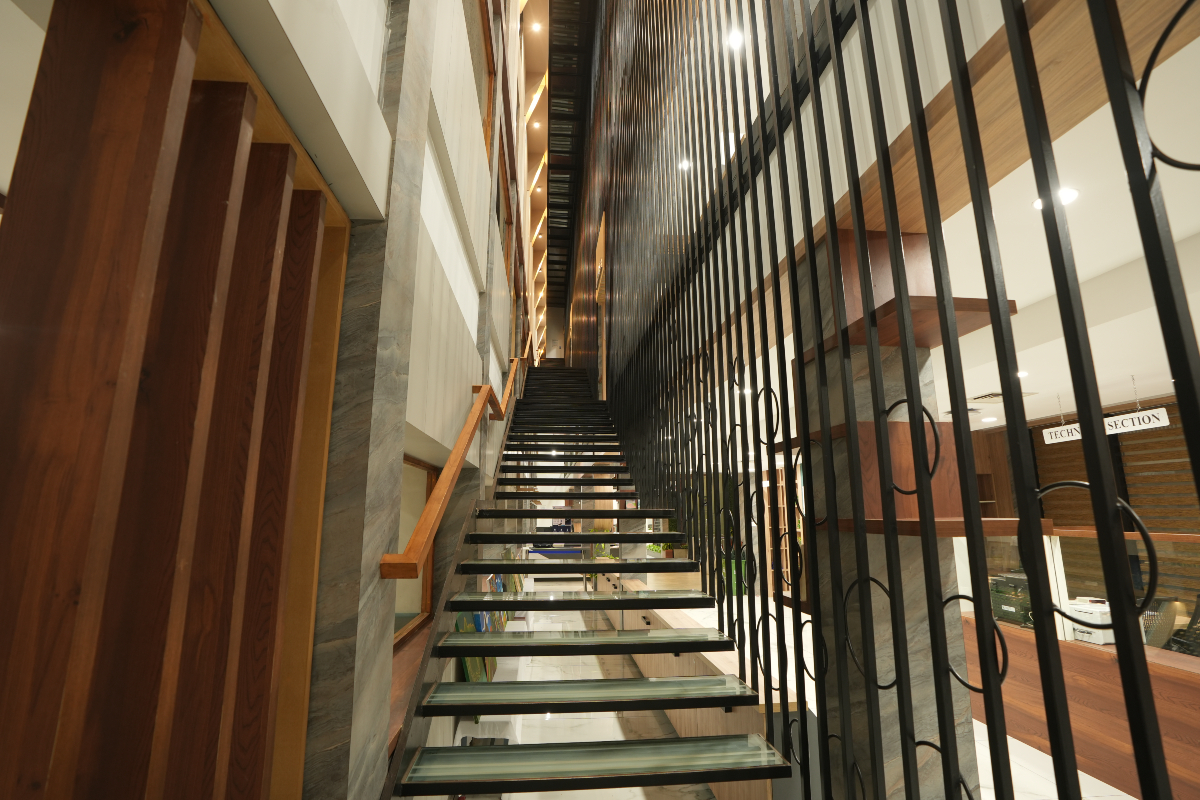
Innovative solutions also defined the construction of the spiral stair and book tower, which were built atop an existing floor using a patented PEN (Pre-Engineered Nail) foundation. Developed by C-DISC Technologies and supported by Kerala Startup Mission, this foundation minimised disruption to the existing vacuum-dewatered flooring while maintaining structural integrity.
The suspended staircase, featuring tubular sections and circular MS rings for added stiffness, was finished with opaque glass treads, doubling as a light well to enhance natural lighting. Additionally, the sitting stair served both as a vertical circulation feature and a dynamic seating area, fostering collaboration and informal interaction among students.
Sustainability was central to the project, with a focus on reducing, reusing, and recycling materials throughout planning, execution, and operation. These innovations not only overcame the challenges but also underscored the library’s role as a forward-thinking, user-centric educational space.
A Touch of Class
The structure was designed using readily available standard steel sections, with the fabrication and erection processes carefully pre-engineered and planned. This approach ensured the project timeline was adhered to while achieving seamless structural integration with the existing concrete buildings.
To connect the new steel framework with the existing structure, CMS and GPR scans were conducted to identify the location of primary reinforcements at column-beam junctions. Bolt holes were precisely drilled to avoid damaging the main reinforcements and column covers.
Chemical anchors were used to secure bolts, with the beam base plates placed and tightened using a torque wrench set to the required torque range. The connections were designed as on-site welded joints, ensuring strength and stability.
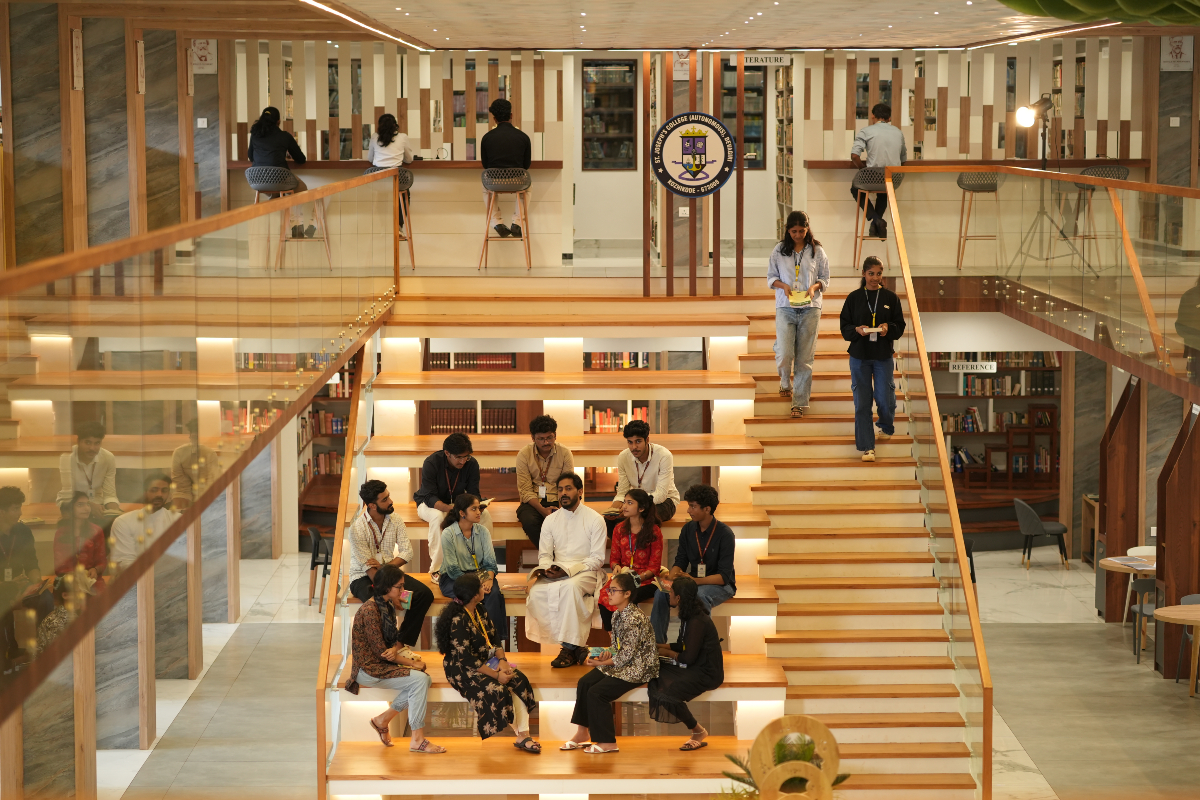
The project also prioritised air and light quality. A ventilation well was incorporated into the spiral staircase and book tower, while the straight-flight suspended stair featured opaque glass treads, enhancing natural light within the structure. The external facade utilised DGU (Double Glazed Units), balancing efficient lighting with energy savings.
The spiral staircase was supported by an inner and outer structural system that also functioned as a bookshelf and ventilation feature, combining aesthetics with functionality.
For all critical connections, Class 8.8 bolts were used, conforming to IS 1367 standards. Bolts were tightened to precise torque values using a torque wrench, and primer and paint were applied after proper tightening to prevent future adjustments. Check nuts were installed in critical areas for added security.
The cantilevered canopy design employed a strut-and-tie mechanism for support. Rods acted as tie members, connecting to extended front columns functioning as struts. The strut columns, cantilevering from the top roof floor, were further stabilised by additional ties connected to rear steel columns. This double strut-and-tie system effectively supported the 7 m long glass canopy, transferring loads entirely to the steel structure without impacting the existing RCC columns.
Going Green
The Devagari College Library project adhered to the principles of Reduce, Reuse, and Recycle, prioritising recyclable materials, repurposed components, and waste-minimising techniques throughout its lifecycle.
Natural lighting, water-saving systems, and energy-efficient materials were integrated into the design to minimise the building’s energy footprint. The external facade utilised Double Glazed Units (DGU), balancing efficient lighting with energy savings.
The innovative PEN foundation, employed for the spiral staircase, minimised excavation damage and preserved the site’s integrity, exemplifying sustainable construction practices.
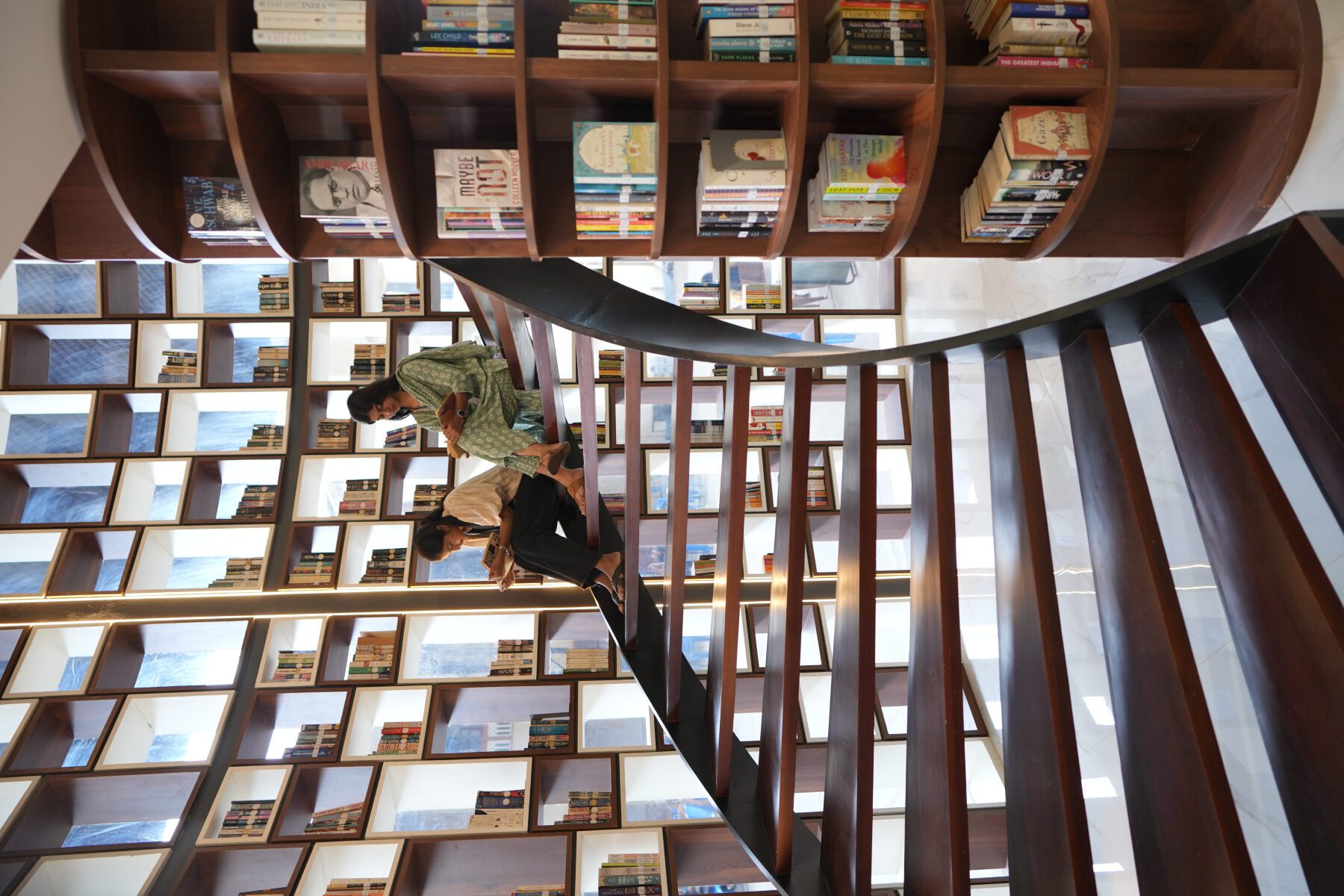
Ventilation and natural light were optimised through the inclusion of a spiral staircase with an integrated book tower, functioning as a ventilation well. The straight-flight suspended stair, finished with opaque glass treads, further enhanced natural light penetration, creating a bright and inviting interior environment.
Steel sections were crafted from primary steel, ensuring suitability for future recycling processes. The fabrication process was meticulously planned, with accurate shop drawings and multiple checkpoints at key stages, including design, detailing, material selection, fabrication, and erection. This ensured precision and efficiency while upholding the project’s sustainability goals.
Quote
“The library project presented an architectural challenge, requiring the integration of diverse spaces, varying levels, and a range of furniture types. The design was meticulously crafted to ensure these elements coexist seamlessly, creating a functional environment that supports the library’s purpose and enhances the user experience. The planning of every aspect of the project, combined with effective site management, enabled its swift completion in under a year.”
– Karan J Fraanc, Architect, Elansa Design Studio
“This project is an exemplary case of how modern engineering techniques applied to easily available conventional materials and sustainable principles can be harmoniously integrated into a constrained site, delivering a structurally efficient, aesthetically pleasing, and environmentally friendly building. We believe that the success of this project will inspire more organisations across education, healthcare, and the hospital industry to adopt steel as the primary structural material.”
– Jeesh Venmarath, Founder, C-DISC Technologies, LLP
Fact File
Project: Devagari College Library, Devagiri
Client: St Joseph’s College (Autonomous), Devagiri
Architect: Elansa Design Studio
Structural Consultant: Forms Ezy Build
Project Management: Elansa Design Studio
Status: Completed
Completion Year: 2024


